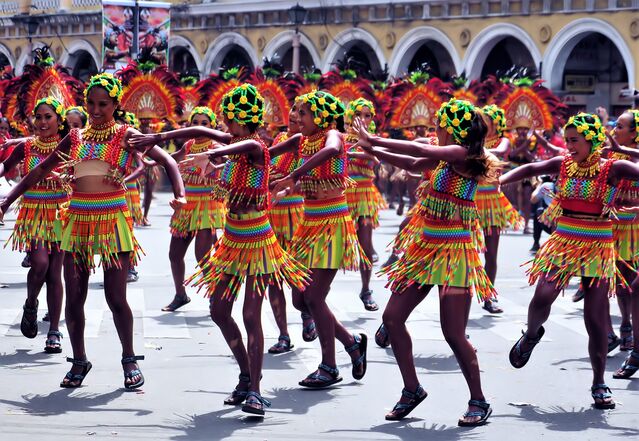Empathy
When Kinesthetic Empathy Goes Viral
How the Jerusalema dance helped the world connect during lockdown.
Posted November 3, 2020

The COVID-19 pandemic will be a story we recount to generations to come. With its phases and stages of lockdown, social distancing and physical isolation. Yet as we sit in our virtual offices, one at the southern tip of Africa and the other in central Europe, we see another social phenomenon unfolding: #jerusalemadancechallenge.
For musician Kgaogelo Moagi, professionally known as Master KG, and vocalist Nomcebo Zikode, Jerusalema is what they do: make good, rhythmic house music. But it spoke to the hearts, minds and bodies of a global community in lockdown. In June 2020, a group of dancers dancing to Jerusalema in Angola went viral, and with that started a global phenomenon.
How we affect each other's physical space
How does dancing to a hit go viral? One way to look at this is through the lens of kinesthetic empathy. In the sciences and, correspondingly, in our lay understanding of what empathy means, two distinct forms of empathy are commonly framed: cognitive and emotional empathy. Cognitive empathy is an understanding of other people’s experiences from a knowing point of view and emotional empathy is where we feel ourselves into the experiences of others. However, empathy is not just a mental and emotional experience but also experienced and expressed through the body. This is what is called kinesthetic empathy.
Kinesthetic empathy is the capacity to participate in somebody’s movement, or their sensory experience of movement. It makes use of mirroring of sensations and movements of the body to enhance connection and synchronicity between people. With kinesthetic empathy, you explore, and become more aware of, how you influence each other’s physical space.
When we dance together or when we see others dancing to a catchy rhythm, we start to display physiological linkage. Our bodies show similarities in patterns of autonomic and nervous system activity such as heart rate and pulse activity. We physically synchronize with one another. Often unaware of what happens, our bodies start falling into the beat of the song, we start moving according to what we see and hear.
Dance choreographers try to bring about this kinesthetic empathy between audience and dance performances. When they succeed, our bodies react impulsively to the movements we watch. The resulting sensations evoke emotions which we often remember years after the event. Watching the movements starts a process in our own body, which makes us feel strongly connected to the acts of the performers, as if it were us performing the movements.
Even a yawn can be contagious
This intense embodied involvement, kinesthetic empathy, is something we have all experienced. Think of when you held your breath or your muscles tensed because somebody in front of you was about to fall out of a tree. Or think of that one person who, when they start laughing, infects you and everyone around, time and time again. We also all have experiences of somebody in the room starting to yawn, with their mouth wide open (despite hiding it behind their hands). Yawning is contagious. Before you know it, half the room is yawning. Interestingly, this is probably how empathy evolved: through the physical synchronization of bodies, signaling our mental and embodied states to our caregivers through smiling and crying.
We mirror each other as an automatic way to connect
Neuroscience discovered the mirror neuron system in our brain involved in this embodied aspect of empathy. Research has for instance shown that when people watch facial expressions of well-known emotions (i.e. anger, sadness, happiness etcetera), they themselves activate the facial muscles involved in these emotions. Correspondingly, areas associated with mirror neurons are activated in the brain when doing so. Yet although mirror neurons probably play a role in empathy, it is not clear whether that role goes beyond automatic imitation into action understanding. In other words, mirror neurons are active at the more basic level of empathy, the level of automatic mimicry.
We are inherently social beings, dependent on each other for much of our survival and satisfaction. In daily interaction with others, we immediately notice and react to intentions and emotions of the people around us. The interaction becomes like a dance where the bodily expressions and emotions shift and change as the "conversation" progresses. We intuitively understand each other through bodily resonance.
How does dancing to a hit go viral?
And that brings us back to the #jerusalemadancechallenge. What happens? How do a song and dance like that go viral? Well, probably because "viral" is exactly the right term for the phenomenon. As individuals, we see a contagiously fun movement and hear a pleasant swing. The lyrics express a universal plea we can all relate to, the intent of which is carried through the voice of the vocalist and the rhythm of the musician. Our bodies engage in kinesthetic empathy, reacting "impulsively" and often unconsciously to the movements we watch, the sounds and intent we hear, and the emotions they express. The resulting emotions evoke our deeper instinct and are accompanied by feelings of pleasure and wellbeing. Before we know it, we lift our feet and "catch" the virus.
The viral effects evoked by the song and the #jerusalemachallenge are expressed not only individually, but also amongst and between social groups. Kinesthetic empathy is about connection. What is remarkable is that this movement encourages connection within groups but also between groups that may ordinarily be competitive. Into an environment of separation and challenge a spark of hope ignited. People across the globe find a way to synchronize and connect even in partial lockdown.
In South Africa, the home of Jerusalema and its creators, Master KG and Nomcebo, the #jerusalemachallenge forged a spark of unity and solidarity amidst many social challenges experienced in the country — to the extent that President Cyril Rhamaphosa encouraged the nation to celebrate Heritage Day by joining the Jerusalema dance challenge.
Keep dancing! Our world is in need of these synchronizing vibes.
Want to learn the dance?
References
Brown, B. J., Kim, S., Saunders, H., Bachmann, C., Thompson, J., Ropar, D., ... & Jackson, G. M. (2017). A neural basis for contagious yawning. Current Biology, 27(17), 2713-2717.
Dimberg, U., Thunberg, M., & Elmehed, K. (2000). Unconscious facial reactions to emotional facial expressions. Psychological science, 11(1), 86-89.
Iacoboni, M. (2009). Mirroring people: The new science of how we connect with others. Farrar, Straus and Giroux.
Kilner, J. M., & Lemon, R. N. (2013). What we know currently about mirror neurons. Current biology, 23(23), R1057-R1062.




